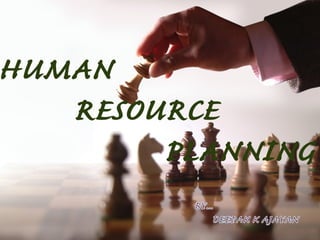
Human resource planning- (Deepak K Ajayan-MHRM 13- DiST)
- 2. MEANING HRP is understood as the process of forecasting an organization's future demand for, and supply of, the right typeof peoplein theright number.
- 3. After this only the HRM department can initiate the recruitment and selection process Its called by manpower planning, personal planning or employment planning
- 4. DEFINITION OF HRP • It includes the estimation of how many qualified peoplearenecessary to carry out the assigned activities, how many people will be available, and what, if anything, must be done to ensure that personal supply equals personnel demand at the appropriate point in thefuture.
- 5. Basically it’s the process by which an organization ensures that it has the right number & kind of people, at the right place, at the right time, capable of effectively & efficiently completing thosetasksthat will help theorganisation achieveitsoverall objectives.
- 7. 1. Analysing Organizational Objectives: The objective to be achieved in future in various fields such as production, marketing, finance, expansion and sales gives the idea about the work to be done in the organization.
- 8. 2. Inventory of Present Human Resources: From the updated human resource information storage system, the current number of employees, their capacity, performance and potential can be analysed
- 9. To fill the various job requirements, the internal sources (i.e., employees from within the organization) and external sources (i.e., candidates from various placement agencies) can be estimated.
- 10. 3. Forecasting Demand and Supply of Human Resource: The human resources required at different positions according to their job profile are to be estimated. The available internal and external sources to fulfill those requirements are also measured.
- 11. 4. Estimating Manpower Gaps: Comparison of human resource demand and human resource supply will provide with the surplus or deficit of human resource.
- 12. 5. Formulating the Human Resource Action Plan: The human resource plan depends on whether there is deficit or surplus in the organization. Accordingly, the plan may be finalized either for new recruitment, training, interdepartmental transfer in case of deficit of termination, or voluntary retirement schemes and redeployment in case of surplus.
- 13. 6. Monitoring, Control and Feedback: It mainly involves implementation of the human resource action plan. Human resources are allocated according to the requirements, and inventories are updated over a period. The plan is monitored strictly to identify the deficiencies and remove it.
- 14. Comparison between the human resource plan and its actual implementation is done to ensure the appropriate action and the availability of the required number of employees for various jobs.
- 16. 1. FUTUREPERSONNELNEEDS • Surplusor deficiency in staff strength • Resultsin theanomaly of surplus labour with thelack of top executives
- 17. 2. COPING WITHCHANGE Enables an enterprise to cope with changes in competitive forces, markets, technology, products & government regulations
- 18. 3, CREATING HIGHLY TALENTED PERSONNEL HR manager must use his/her ingenuity to attract & retain qualified & skilled personnel Succession planning
- 19. 4, PROTECTION OF WEAKER SECTIONS SC/ST candidates, physically handicapped, children of the socially disabled & physically oppressed and backward classcitizens.
- 20. 5.5. INTERNATIONALSTRATEGIESINTERNATIONALSTRATEGIES Fill key jobs with foreign nationals and re-assignment of employees from within or acrossnational borders
- 21. 6. FOUNDATION FOR PERSONNEL FUNCTIONS Provides information for designing & implementing recruiting, selection, personnel movement (transfers, promotions, layoffs) & training & development
- 22. 7. INCREASING INVESTMENTS IN HUMAN RESOURCES Human assetsincreasein value 8. RESISTANCETO CHANGEAND MOVE Proper planning isrequired to do this
- 23. 9. OTHERBENEFITS • Upper management hasabetter view of theHR dimensionsof businessdecision • Moretimeisprovided to locate talent
- 24. • Better opportunitiesexist to includewomen & minority groups in futuregrowth plans • Better planning of assignmentsto develop managerscan bedone
Notas do Editor
- MAKE PLAN
- Helps Find out the deviates from is standard, normal, or expected.
- It helps to deal effectively with something difficult.
- the quality of being clever, original, and inventive
- key –job : a job that can be evaluated accurately and then used as representative of other similar jobs